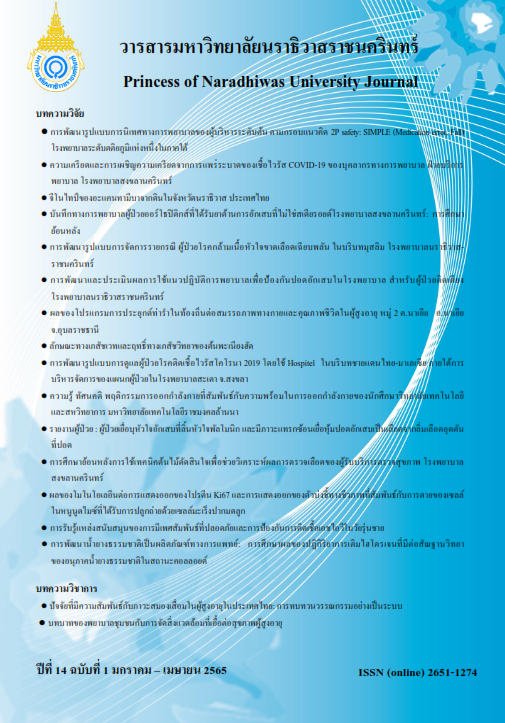Nursing Records of Orthopedic Patients Treated with Non- Steroidal Anti-inflammatory Drugs; NSAIDs, Songklanagarind Hospital: A Retrospective study
Keywords:
Nursing record, Orthopedic patients, Non-steroidal anti-inflammatory drugsAbstract
This research aimed to study the nursing’s record on care of orthopedic patients treated with NSAIDs. The theoretical framework of the study was derived from the concept of nursing process. The 276 subjects were orthopedic patients treated with NSAIDs admitted to the orthopedic ward of Songklanagarind Hospital between 1 January - 30 June 2017. The data were collected from medical record. The instruments composed of 2 parts: 1) patients’ general information including personal data, illness status and treatment, signs and symptoms during hospitalization, information about NSAIDs treated, and date of discharge, 2) the checklist for nursing record of orthopedic patients treated with NSAIDs including initial assessment form, medication record form, nursing problem list, nursing progress note, continuing nursing care plan and discharge summary, and graphic sheet record. Data were analyzed using descriptive statistics, which were frequency, percentage, mean, and standard deviation
The study showed that the documents widely used in the hospital were 1) initial nursing assessment form including drinking, smoking and other narcotic substances history shown at 98.2%, 2) medication records which explicit electronic medication card at 96%, 3) explicit continuing nursing care plan and discharge summary form included how to use, side effects and how to behave for prevention of NSAIDs adverse reactions including help sources at 45.2% followed by 4) graphic sheet that recorded intake-output at 43.8%, 5) nursing problem list which records were corresponded with care objectives at 0.4% and 6) nursing progress note which none of problems and intervention on NSAIDs were mentioned at all.
References
Achanupap, S. (2011). Textbook for general medical examination (3rd ed.). Bangkok: Pimdee Bangkok. (in Thai)
Cheevakasemsook, A. (2008). Nursing Process and Health Assessment: Theory and Practice (1st ed.). Nonthaburi: Sukhothai Thammathirat. (in Thai)
Chongtrakul, P. (2015). RDU Hospital: the pathway to rational drug use. Thai Journal of Pharmacology, 37(1), 48-62.
Chou, R., Gordon, D.B., de Leon-Casasola, O.A., Rosenberg, J.M., Bickler, S., Brennan, T., et al., (2016). Management of Postoperative Pain: a clinical practice guideline from the American pain society, the American Society of Regional Anesthesia and Pain Medicine, and the American Society of Anesthesiologists' committee on regional anesthesia, executive committee, and administrative council. The Journal of Pain, 17(2), 131-157.
Ekakul, T. (2000). Research methodology in behavioural. Ubon Ratchathani: Faculty of Education Ubon Ratchathani Rajabhat University. (in Thai)
Ellis, J.R., & Nowlis, E.A. (1994). Nursing, a human needs approach: Lippincott.
Feenstra, J., Heerdink, E. R., Grobbee, D. E., & Stricker, B. H. C. (2002). Association of nonsteroidal anti-inflammatory drugs with first occurrence of heart failure and with relapsing heart failure: the Rotterdam Study. Archives of Internal Medicine, 162(3), 265-270.
Gutthann, S.P., Rodríguez, L.A.G., Raiford, D.S., Oliart, A.D., & Romeu, J.R. (1996). Nonsteroidal anti-inflammatory drugs and the risk of hospitalization for acute renal failure. Archives of Internal Medicine, 156(21), 2433-2439.
Hospital Information System of Songklanagarind Hospital (HIS). (2017). Statistic of patient admit in orthopedic ward songklanagarind. Songkla. Songklanagarind. (inthai)
Juntchum, W. Vicheanpuk, R. & Kanchanabatr, B. (2011). Nurses’ Perception of Quality Nursing Documentation, 11th Region Community Hospital. Journal of Nurses Association of Thailand, North-Eastern Division, 29(4), 5-12.
Korsuntirat, T. (2010). Non-steroidal anti-inflammatory drugs: NSAIDs. Journal of Medication and Health Sciences, 17(2), 97-113.
Lertsinudom, S. (2012). Review of using Cox2 Specific Non-Steroidal anti-inflammatory drugs in Orthopedic outpatient Department, Khon Kaen Hospital. North-Eastern Thai Journal of Neuroscience, 7(1), 15-32.
Loydunshay, J. (2011). Evalation of using selective Cyclooxygennase-2 inhibitors in Queen Sawang Vadana memorial hospital. Srinakharinwirot University. Journal of Science and Technology, 3(5), 30-39.
Layer, P.W., & Camp, N.H. (1995). Nursing Documentation: A nursing Process Approach. St. Louis: Mosby.
Nursing Division, (2001). Quality assurance in hospital: Inpatient Nursing Service. Bangkok: Office of the Permanent Secretary of Public Health. (in Thai)
Nursing Division, Ministry of Public Health. (1996). Nursing quality control (2nd ed.). Bangkok: Thammasat. (in Thai)
Potter, P.A., & Perry, A.G. (2005). Virtual Clinical Excursions 3.0 to Accompany Fundamentals of Nursing: Mosby Incorporated.
Pountos, I., Georgouli, T., Bird, H., & Giannoudis, P. V. (2011). Non-steroidal anti-inflammatory drugs: prostaglandins, indications, and side effects. International Journal of Interferon, Cytokine and Mediator Research, 3, 19.
Schneider, V., Lévesque, L.E., Zhang, B., Hutchinson, T., & Brophy, J.M. (2006). Association of selective and conventional nonsteroidal anti- inflammatory drugs with acute renal failure: a population-based, nested case-control analysis. American Journal of Epidemiology, 164(9), 881-889.
Thailand Nursing and Midwifery Council (2010). Professional Nursing and Midwifery Act, 1985. Additional fixes by Professional Nursing and Midwifery Act 2nd 1997. Bangkok: The Best graphic and printing. (in Thai).
The Royal College of Anesthesiologists of Thailand, & Thai Association for the Pain Study of Thailand, (2019). Clinical Guidance for Acute postoperative Pain Management. The Royal College of Anesthesiologists of Thailand, Bangkok. (in Thai).
The Royal College of Orthopedic Surgeons of Thailand. (2010). Practice Guideline of Osteoporosis Care. Retrieved 10 January, 2020 from http://www.pharutth.net/disdownload1/9.pdf. (in Thai).
Udomchaisakul, J. (2008). Diseases and Medicine, Musculoskeletal System. (2nd Ed.). Bangkok: Sistikorn. (in Thai)
Walter, H.H. (2010). Non-steroidal anti‑inflammatory drugs and the kidney. Pharmaceuticals (Basel), 3, 30.
Additional Files
Published
How to Cite
Issue
Section
License
Copyright (c) 2022 Princess of Naradhiwas University Journal

This work is licensed under a Creative Commons Attribution-NonCommercial-NoDerivatives 4.0 International License.




